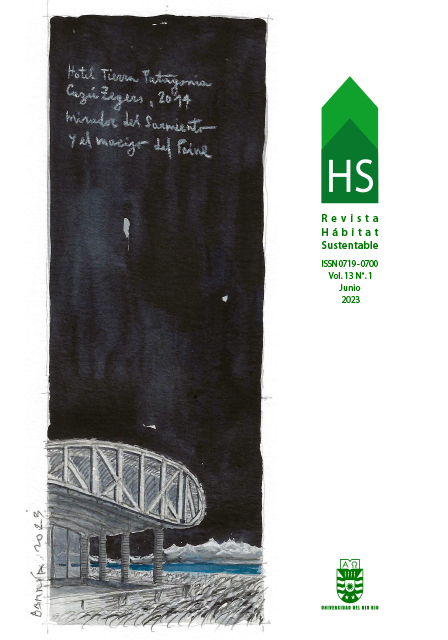Melhoria do desempenho térmico de escolas na Região Alto-Andina do Peru. O caso das "salas de aula modulares pré-fabricadas do tipo helada do PRONIED”
DOI:
https://doi.org/10.22320/07190700.2023.13.01.05Palavras-chave:
projeto bioclimático, estratégias passivas, desempenho térmico, simulação de energiaResumo
Diante do déficit qualitativo e quantitativo de infraestrutura educacional nas áreas rurais alto-andinas do Peru, o Estado peruano vem, nos últimos anos, investindo e apoiando soluções modulares, buscando eficiência nos processos de construção. A proposta específica, com ênfase especial no design bioclimático, é a "Sala de aula modular pré-fabricada do tipo Helada". No entanto, os usuários têm expressado desconforto com essas novas instalações. Este estudo mostra o processo de medição realizado em um módulo construído, que permitiu calibrar e validar o modelo usando um software de simulação, para propor melhorias no projeto que possam contribuir para futuras construções. Tomando o modelo adaptativo de conforto térmico como referência, confirmou-se que as temperaturas internas estavam abaixo dos limites de conforto térmico nas primeiras horas da manhã e bem acima deles perto do meio-dia, em torno de 6 ºC e 7 ºC, respectivamente. Com a aplicação de estratégias bioclimáticas complementares, foi possível melhorar consideravelmente as condições térmicas internas, embora não o suficiente para alcançar o conforto no início da manhã. Isso se deve ao fato de as temperaturas externas noturnas serem muito baixas, de o edifício ficar desabitado durante toda a noite, de não haver massa térmica no envelope e de não haver sistemas solares ativos ou ar-condicionado mecânico.
Downloads
Referências
ASHRAE Standard (2017). Standard 55-2017 Thermal environmental conditions for human occupancy. Ashrae: Atlanta, GA, USA.
CHUI BETANCUR, H. N., HUAQUISTO RAMOS, E., QUISPE, G. B., CANALES GUTIÉRREZ, Á. & CALATAYUD MENDOZA, A. P. (2022). Características de la arquitectura vernácula en zonas altoandinas de Perú. Una contribución al estudio del mundo rural. Cuadernos de Vivienda y Urbanismo, 15, 21-21. DOI: https://doi.org/10.11144/Javeriana.cvu15.cavz
BOS, M. S., GANIMIAN, A. J., VEGAS, E. & ALFONSO M. (2014). Brief Nº13: Perú en PISA 2012 logros y desafíos pendientes. BID. Retrieved from: https://repositorio.minedu.gob.pe/handle/20.500.12799/3814
BURGA, J. (2010). Arquitectura vernácula peruana: un análisis tipológico. Colegio de Arquitectos del Perú.
GENG, Y., JI, W., LIN, B. & ZHU, Y. (2017). The impact of thermal environment on occupant IEQ perception and productivity. Building and Environment, 121, 158-167. DOI: https://doi.org/10.1016/j.buildenv.2017.05.022
GIVONI, B. (1992). Comfort, climate analysis and building design guidelines. Energy and buildings, 18(1), 11-23. DOI: https://doi.org/10.1016/0378-7788(92)90047-K
HAVES, P., RAVACHE, B., FERGADIOTTI, A., KOHLER, C. & YAZDANIAN, M. (2019). Accuracy of HVAC Load Predictions: Validation of EnergyPlus and DOE-2. Using an Instrumented Test Facility. In Proceedings of Building Simulation. DOI: https://doi.org/10.26868/25222708.2019.211268
KÜKRER, E. & ESKIN, N. (2021). Effect of design and operational strategies on thermal comfort and productivity in a multipurpose school building. Journal of Building Engineering, 44, 102697. DOI: https://doi.org/10.1016/j.jobe.2021.102697
MANZANO-AGUGLIARO, F., MONTOYA, F. G., SABIO-ORTEGA, A. & GARCÍA-CRUZ, A. (2015). Review of bioclimatic architecture strategies for achieving thermal comfort. Renewable and Sustainable Energy Reviews, 49, 736-755. DOI: https://doi.org/10.1016/j.rser.2015.04.095
MAZZEO, D., MATERA, N., CORNARO, C., OLIVETI, G., ROMAGNONI, P. & DE SANTOLI, L. (2020). EnergyPlus, IDA ICE and TRNSYS predictive simulation accuracy for building thermal behaviour evaluation by using an experimental campaign in solar test boxes with and without a PCM module. Energy and Buildings, 212, 109812. DOI: https://doi.org/10.1016/j.enbuild.2020.109812
MOLINA, J. R., LEFEBVRE, G., ESPINOZA, R., HORN, M. & GÓMEZ, M. M. (2021). Bioclimatic approach for rural dwellings in the cold, high Andean region: A case study of a Peruvian house. Energy and Buildings, 231, 110605. DOI: https://doi.org/10.1016/j.enbuild.2020.110605
Programa Nacional de Infraestructura Educativa, PRONIED del Ministerio de Educación, MINEDU (2021). Ficha de Homologación de Módulo Prefabricado Aula tipo Heladas. Retrieved from: https://www.gob.pe/institucion/pronied/campa%C3%B1as/4440-fichas-de-homologacion-de-modulos-prefabricados
SÁEZ, E., & CANZIANI, J. (2020). Vernacular architecture and cultural landscapes in the Sondondo Valley (Peru). The International Archives of Photogrammetry, Remote Sensing and Spatial Information Sciences, 44(M1), 175-180. DOI: https://doi.org/10.5194/isprs-archives-XLIV-M-1-2020-175-2020
SZOKOLAY, S. (2012). Introduction to architectural science. Routledge. DOI:
https://doi.org/10.4324/9780080473130
TORRES PUÑEZ, C. M. (2021). Construyendo la educación: infraestructura como determinante del rendimiento académico en el Perú 2000-2015. [Thesis for the degree of Economist, Universidad de Lima]. Retrieved from: https://hdl.handle.net/20.500.12724/13874
TREMBLAY, J. C. & AINSLIE, P. N. (2021). Global and country-level estimates of human population at high altitude. Proceedings of the National Academy of Sciences, 118(18), e2102463118. DOI: https://doi.org/10.1073/pnas.2102463118
VIDAL, J. P. (2014). Las ocho regiones naturales del Perú. Terra Brasilis Revista da Rede Brasileira de História da Geografia e Geografia Histórica, (3). DOI: https://doi.org/10.4000/terrabrasilis.1027
WARGOCKI, P., PORRAS-SALAZAR, J. A. & CONTRERAS-ESPINOZA, S. (2019). The relationship between classroom temperature and children’s performance in school. Building and Environment, 157, 197-204. DOI: https://doi.org/10.1016/j.buildenv.2019.04.046
WIESER, M., RODRÍGUEZ-LARRAÍN, S. & ONNIS, S. (2021). Bioclimatic strategies for high altitude tropical cold climate. Prototype validation in Orduña, Puno, Perú. Estoa. Revista de la Facultad de Arquitectura y Urbanismo de la Universidad de Cuenca, 10(19), 09-19. DOI: https://doi.org/10.18537/est.v010.n019.a01
ZOMORODIAN, Z. S., TAHSILDOOST, M. & HAFEZI, M. (2016). Thermal comfort in educational buildings: A review article. Renewable and Sustainable Energy Reviews, 59, 895-906. DOI: https://doi.org/10.1016/j.rser.2016.01.033
Downloads
Publicado
Como Citar
Edição
Secção
Licença
Direitos de Autor (c) 2023 Martin Wieser, Antonio Garaycochea, Varinia Prada

Este trabalho encontra-se publicado com a Licença Internacional Creative Commons Atribuição-CompartilhaIgual 4.0.
O conteúdo dos artigos publicados em cada número do Habitat Sustentável é da exclusiva responsabilidade dos autores e não representa necessariamente o pensamento ou compromete a opinião da Universidad del Bío-Bío.
Os autores mantêm os seus direitos de autor e concedem à revista o direito de primeira publicação da sua obra, que está simultaneamente sujeita à Licença de Atribuição Creative Commons CC BY-SA que permite a outros partilhar, transformar ou criar novo material a partir desta obra para fins não comerciais, desde que a autoria e a primeira publicação nesta revista sejam reconhecidas, e as suas novas criações sejam licenciadas sob os mesmos termos.











 Programa de Informação Científica/Concurso Fondos de Publicación de Revistas Científicas 2018/ Proyecto Mejoramiento de Visibilidad de Revistas UBB (Código:FP180007)
Programa de Informação Científica/Concurso Fondos de Publicación de Revistas Científicas 2018/ Proyecto Mejoramiento de Visibilidad de Revistas UBB (Código:FP180007)





